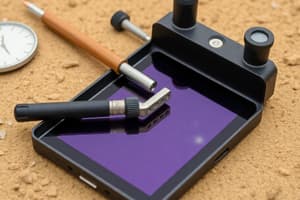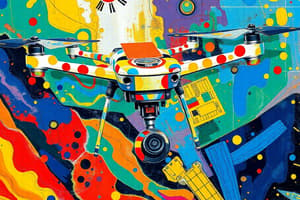Podcast
Questions and Answers
What is one of the significant shifts in archaeology in recent times?
What is one of the significant shifts in archaeology in recent times?
- Transition from digital records to pen and paper
- More isolated and individual research practices
- Decrease in data analysis and storage
- Advancements in technology impacting the field (correct)
How have digital databases impacted the field of archaeology?
How have digital databases impacted the field of archaeology?
- Slowed down the pace of discovery
- Made data analysis impossible
- Facilitated collaboration and accelerated the pace of discovery (correct)
- Limited access to data for researchers
Which technology has made it possible to map underground structures without invasive excavation?
Which technology has made it possible to map underground structures without invasive excavation?
- Satellite imagery
- X-ray machines
- Metal detectors
- Ground-penetrating radar (GPR) (correct)
How have laser scanning and 3D modeling impacted the study of archaeological sites and artifacts?
How have laser scanning and 3D modeling impacted the study of archaeological sites and artifacts?
What role have drones played in archaeology?
What role have drones played in archaeology?
What technological advancement has enabled archaeologists to analyze the chemical composition of artifacts?
What technological advancement has enabled archaeologists to analyze the chemical composition of artifacts?
What tool has been effective in engaging students and fostering a deeper understanding of archaeology?
What tool has been effective in engaging students and fostering a deeper understanding of archaeology?
What has drones enabled archaeologists to do more efficiently?
What has drones enabled archaeologists to do more efficiently?
What has revolutionized the way archaeologists decode and interpret ancient scripts and artifacts?
What has revolutionized the way archaeologists decode and interpret ancient scripts and artifacts?
Which of the following is not a benefit of the tech revolution in archaeology?
Which of the following is not a benefit of the tech revolution in archaeology?
Flashcards
Digital Records in Archaeology
Digital Records in Archaeology
Transition from pen and paper to digital formats for storing and analyzing data.
Ground-Penetrating Radar (GPR)
Ground-Penetrating Radar (GPR)
A technology used to map underground structures without excavation.
3D Modeling
3D Modeling
Creating detailed replicas of archaeological sites and artifacts using technology.
Drones in Archaeology
Drones in Archaeology
Signup and view all the flashcards
High-Resolution Imaging
High-Resolution Imaging
Signup and view all the flashcards
Machine Learning in Decoding
Machine Learning in Decoding
Signup and view all the flashcards
X-ray Fluorescence (XRF)
X-ray Fluorescence (XRF)
Signup and view all the flashcards
Fourier Transform Infrared Spectroscopy (FTIR)
Fourier Transform Infrared Spectroscopy (FTIR)
Signup and view all the flashcards
Virtual Reality (VR) in Education
Virtual Reality (VR) in Education
Signup and view all the flashcards
Augmented Reality (AR) in Archaeology
Augmented Reality (AR) in Archaeology
Signup and view all the flashcards
Study Notes
Archaeology's Tech Revolution
The world of archaeology has seen a significant shift in recent times, driven primarily by advancements in technology. These changes have greatly impacted the way we study and understand our past, transforming the field into a more efficient, accurate, and interconnected discipline.
Digital Discoveries
One of the most prominent changes in archaeology is the transition from pen and paper to digital records. This shift has allowed archaeologists to store and analyze vast amounts of data in a more organized and efficient manner. Moreover, digital databases can be easily shared and accessed by other researchers, facilitating collaboration and accelerating the pace of discovery.
Imaging Innovations
Advancements in imaging technology have revolutionized the way archaeologists analyze and document their findings. For example, ground-penetrating radar (GPR) has made it possible to map underground structures and survey landscapes without the need for invasive excavation. Similarly, laser scanning and 3D modeling have enabled the creation of highly detailed and accurate replicas of archaeological sites and artifacts, allowing researchers to study and analyze these items in greater detail.
Droning in Archaeology
Drones have emerged as a powerful tool in archaeology, providing a bird's-eye view of sites and landscapes. This technology has enabled archaeologists to conduct surveys and reconnaissance more efficiently, and has even led to the discovery of previously unknown sites. In addition, drones can capture high-resolution images and video, which can be used to create detailed maps and models of archaeological sites.
Cracking Codes and Crypts
Technological advancements have also revolutionized the way archaeologists decode and interpret ancient scripts and artifacts. For example, advances in computer algorithms and machine learning have enabled researchers to analyze complex texts and symbols more efficiently, leading to new insights into ancient cultures and societies. Furthermore, the use of techniques like X-ray fluorescence (XRF) and Fourier transform infrared spectroscopy (FTIR) has allowed archaeologists to analyze the chemical composition of artifacts, providing valuable information about their origin and age.
Reimagining the Classroom
The integration of technology in archaeology has also transformed the way we educate future generations of researchers. Many universities and institutions have embraced the use of virtual reality (VR) and augmented reality (AR) to create immersive learning experiences that transport students to ancient sites and artifacts. These tools have proven to be highly effective in engaging students and fostering a deeper understanding of the subject matter.
A Connected Future
In conclusion, the tech revolution in archaeology has brought about numerous advancements that have transformed the way we study and understand our past. From digital records and imaging technologies to drones and crypt-cracking tools, these innovations have opened up new avenues for research and discovery. As we move forward, it is expected that technological advancements will continue to shape and advance the field of archaeology, providing new insights into our shared human history.
Studying That Suits You
Use AI to generate personalized quizzes and flashcards to suit your learning preferences.





